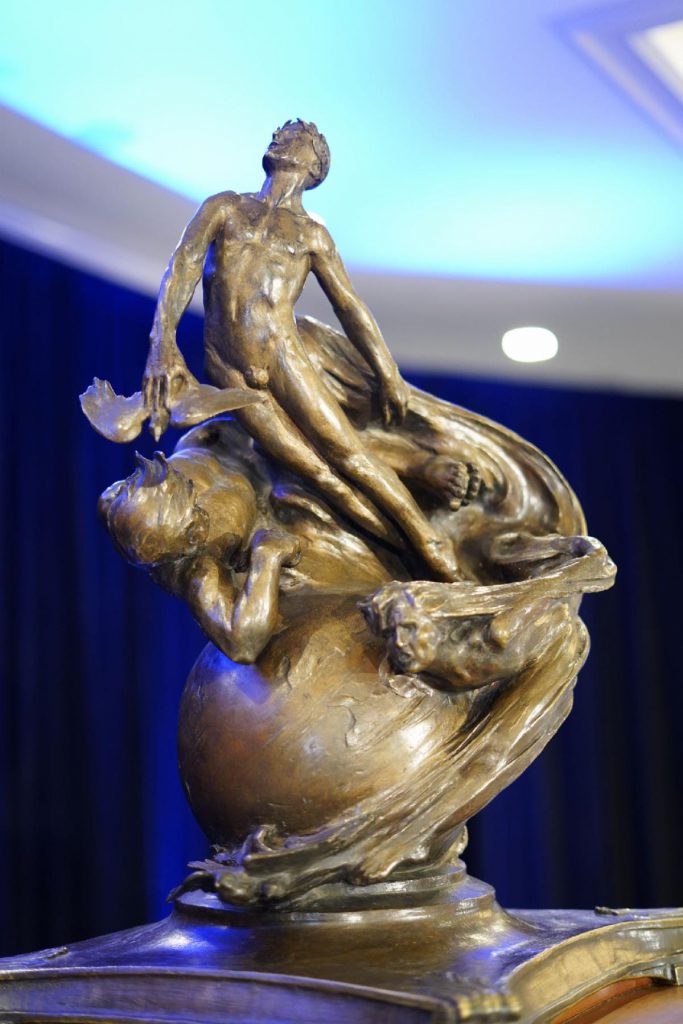The National Aeronautic Association (NAA) is pleased to announce that NASA’s Jet Propulsion Laboratory (JPL) Ingenuity Mars Helicopter Team has been named the recipient of the 2021 Robert J. Collier Trophy for ““… the first powered, controlled flight of an aircraft on another planet, thereby opening the skies of Mars and other worlds for future scientific discovery and exploration.”

Since 1911, the Collier Trophy has been awarded annually for ““… the greatest achievement in aeronautics or astronautics in America, with respect to improving the performance, efficiency, and safety of air or space vehicles, the value of which has been thoroughly demonstrated by actual use during the preceding year.” The list of Collier recipients represents a timeline of air and space achievements, marking major milestones in the history of flight. The 525-pound bronze trophy is on permanent display at the Smithsonian’s National Air and Space Museum in Washington, D.C.
“While NASA’s Ingenuity Mars Helicopter team expanded the flight envelope by 100-million miles, we know we didn’t do it alone,” said Larry James, Interim-Director of NASA’s Jet Propulsion Laboratory in Southern California. “For it was the efforts and ingenuity of those women and men who developed and tested cutting-edge vehicles before us that helped make powered-controlled flight on another planet possible. That our Mars Helicopter name will now appear on this iconic trophy alongside so many of these air and space giants is an honor, and fuels us to continue exploring the skies over the Red Planet.”
One hundred and seventeen years after the Wright brothers succeeded in making the first powered flight on our planet, the Ingenuity Mars Helicopter performed this amazing feat on another world. On April 19, 2021, Ingenuity lifted off from the surface of Mars, climbed to the prescribed altitude of 10 feet, and maintained a stable hover for 30 seconds. It then descended, touching back down on the surface of Mars after logging a total of 39.1 seconds of flight, thereby becoming the first aircraft in history to make a powered-controlled flight on another planet.
Since its first flight, Ingenuity has accomplished all of its technology demonstration goals and successfully transitioned into service as a science scout for the Perseverance rover, investigating promising science targets and safe routes of travel for its companion and demonstrating the efficiency and safety benefits of the first multi-robot explorers on another planet. The helicopter’s color camera has also been used to collect high-definition imagery to assist the science team in identification and assessment of intriguing, and in some cases previously unknown, geologic features. To date, the mission’s official logbook has entries for 24 flights and a cumulative flight time of over 43 minutes.
The Ingenuity Mars Helicopter Team displayed exceptional creativity, perseverance, and dedication to advancing the state of the art in aeronautics and astronautics. The helicopter’s flight dynamics and controls were invented from first principles due to the thin atmosphere on Mars and an entirely new kind of test program had to be developed from scratch. The result – a solar powered, counter-rotating, propeller-driven planetary aircraft that stands 22 inches tall, weighs just 4 pounds, and meets the stringent requirements of both spacecraft and aircraft.
“I recently travelled to Kitty Hawk, North Carolina, and was in awe to be able to stand where the Wrights achieved the first flight on our planet,” said Bob Balaram, Chief Engineer emeritus and innovator of the Mars helicopter design. “It is my hope that, some day, when people travel to Mars’ Jezero Crater that they consider visiting where the first flight on that world occurred!”
Simultaneously honoring the past and inspiring the future of aviation and space, the Ingenuity Mars Helicopter carries a small swatch from the left wing of the first Wright Flyer with it into the Martian skies on every flight. Ingenuity’s success will make possible a new generation of solar system explorers that will scout the unpaved Martian road ahead, keeping human voyagers safe and informing our world of future discoveries.
“The challenges of autonomously flying a helicopter in the atmosphere of Mars cannot be overstated,” expressed NAA Chairman, Jim Albaugh. “This accomplishment truly warrants and has earned this year’s Collier Trophy.”

NAA President, Greg Principato added, “Almost no one thought a helicopter could be flown on Mars. There were many who thought the project was not worth the effort. It is by overcoming such doubts that great achievements happen and that’s what the Ingenuity Team did. It is our honor to present them with the 2021 Collier Trophy.”
The Collier Trophy Selection Committee, comprised of 44 aviation and aerospace professionals, reviewed presentations from four nominees and selected the NASA/JPL Ingenuity Mars Helicopter Team as the recipient of the Collier Trophy on March 31, 2022.
The 2021 Collier Trophy will be formally presented on June 9, 2022, in Washington, D.C. For more information or to view a complete list of previous recipients of the Collier Trophy, please the NAA website.


